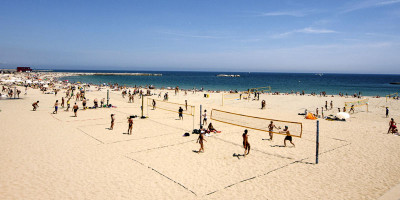
Photo by Presidential Press and Information Office from Wikimedia
Top 10 Remarkable Facts about Azerbaijan Carpet Museum
Azerbaijan National Carpet museum is located in Baku, and displays Azerbaijani carpets and rugs with historical and modern weaving techniques and materials.
It has the largest collection of Azerbaijani carpets in the world. It was opened in 1967 at Neftchiler Avenue and moved to a new building on Baku’s Seafront Park in 2014.
The structure of the building looks like a rolled carpet and was designed by Austrian architect Franz Janz, the building took over six years to construct.
Here are 10 Remarkable Facts about Azerbaijan Carpet Museum
1. The Museum Organizes Public Lectures and Study Courses on Carpets and Applied Arts

Photo by Interfase from Wikimedia
The Azerbaijan Carpet Museum organizes public lectures and study courses on carpets and applied arts. It has a bookstore selling books on Azerbaijani crafts and carpet art.
The museum also holds a permanent collection from the Shusha Museum of History from the city of Shusha. Some of the exhibited items from the Shusha museum were part of 600 carpets moved out of the museum before it was captured by Armenian troops in 1992.
The collection is now displayed at the museum in an exhibition titled “Burned Culture”.
2. A section of the museum is devoted to Latif Karimov
The third level of the museum is entirely devoted to Latif Karimov. It presents and acknowledges Karimov as the “undisputed authority in the science and art of carpet weaving.
Latif Huseyn Oglu Karimov was an Azerbaijani carpet designer known for his contributions to a variety of artistic fields, as well as for several books classifying and describing various designs of Azerbaijani rugs.
On the museum’s second level there is a specific woven piece meant to reflect Karimov’s classification and groupings of carpets. It was described as the most striking exhibit by the International Journal of Heritage Studies.
3. Visit the Museum International Exhibition

Photo by Interfase from Wikimedia
The museum does research and public service work. Every year, state and international exhibitions are organized and catalogs on carpets are printed.
The museum has also held exhibitions in more than 30 countries including France, Germany, England, Japan, and Netherland.
The museum participated in a UNESCO-organized exhibition in Paris dedicated to Fuzûlî in 1998. It also held another one in 1999 dedicated to the 1,300th anniversary of the Book of Dede Korkut displaying carpets and folk-applied art items.
4. The Structure of the Building is like a Rolled carpet

Photo Source: Wikimedia
The structure of the building was designed to look like a rolled carpet and it took over six years to construct.
It opened to the public in 2014 and houses more than 10,000 exhibits. They include flat-woven carpets, pile carpets, objects from woven materials, metalwork, textiles, embroideries, and jewelry.
5. Learn more about Ceramic and Metal Work at the Museum
Azerbaijan Carpet Museum was established in 1967. At the time of its establishment, it was the only museum that was dedicated to the art of carpet weaving.
The main purpose of the creation of the museum was to store, research, and demonstrate unique examples of carpet weaving art, which are Azerbaijan’s national heritage.
The museum vault houses seven collections such as Pile Carpets, Flat woven Carpets, and Carpet products. It also has Artistic Metalworks, Ceramics, Glass, Textiles, and Jewelry.
Today, the Azerbaijan Carpet Museum not only stores a rich collection of artifacts and carpets but also operates as the site for the research of traditional carpet weaving art and its popularization within world culture.
6. The Flat Woven Carpet at the museum comprises over 600 items

Image Source: Wikimedia
The flat-woven carpets collection comprises over 600 items, mainly dating from the 18th to 20th centuries. They are distinguished by their weaving techniques, as well as by their regional compositions, ornamentation, and color schemes.
Other flat-woven carpets, such as Varni, Shadda, Zili, and Sumakh are all woven by wrapping the weft around the warp. It allows the creation of a stylized dragon in the shape of the letter ‘S’, or ‘Z’,.
These flatweaves were created to be used in everyday life for flooring, tent coverings, curtains, and blankets, as well as for use as tablecloths and other household textiles.
7. It Houses Carpets with a History from the 17th Century
The pile of knotted carpets is the core of the collection with over 2,300 items dating from the 17th to early 20th century. They represent the four major types of carpet weaving in Azerbaijan.
The four weaving Carpets are Guva-Shirvan, Ganja-Gazakh, Karabakh, and Tabriz. There are over 600 documented classic designs of these carpets with the oldest being a 17th-century dragon design in the Karabakh style. It was donated to the museum in 2013.
Motifs and their meanings are integral to their design and a wide range of symbols are used in Azerbaijan.
8. The Cross Motif is Most Common at the Museum

Photo Source: Wikimedia
The Cross Motif is Most Common at the Museum, which is an ancient religious sign used in many cultures and regions. It is also associated with the ideas of fertility and wealth.
It is believed ancient cultures saw the cross as a symbol of the sun that personified the ideas of birth and fertility. Subsequently, the symbol has acquired many other interpretations with the most widespread being the form of a diamond-shaped cross with hooks on all four sides.
The Greek cross also symbolized heavenly fire and light coming from the God of Tengri and was a popular design for many objects. It survives today on fragments of early carpets in museums throughout the world.
9. The museum was declared an Intangible Cultural Heritage by UNESCO
The traditional art of Azerbaijan carpet weaving was declared an Intangible Cultural Heritage by UNESCO IN 2010 recognizing its continued importance and place in world culture.
In Medieval Europe, these oriental carpets were regarded as a sign of great wealth. This is found in paintings from the 14th century onwards. Parallel with the general development of Renaissance painting, these oriental carpets were initially included in paintings of Christian saints, or religious scenes.
10. The Museum received its National Status in 2019
In recent years, the National Museum enriched its collection with museum objects of historical and artistic significance.
This was done within the State Program for the Preservation and Development of Carpet Art in Azerbaijan.
In 2019, the museum received national status for its significant contribution to the popularization and promotion of Azerbaijani Carpet Weaving Art.

 English
English










